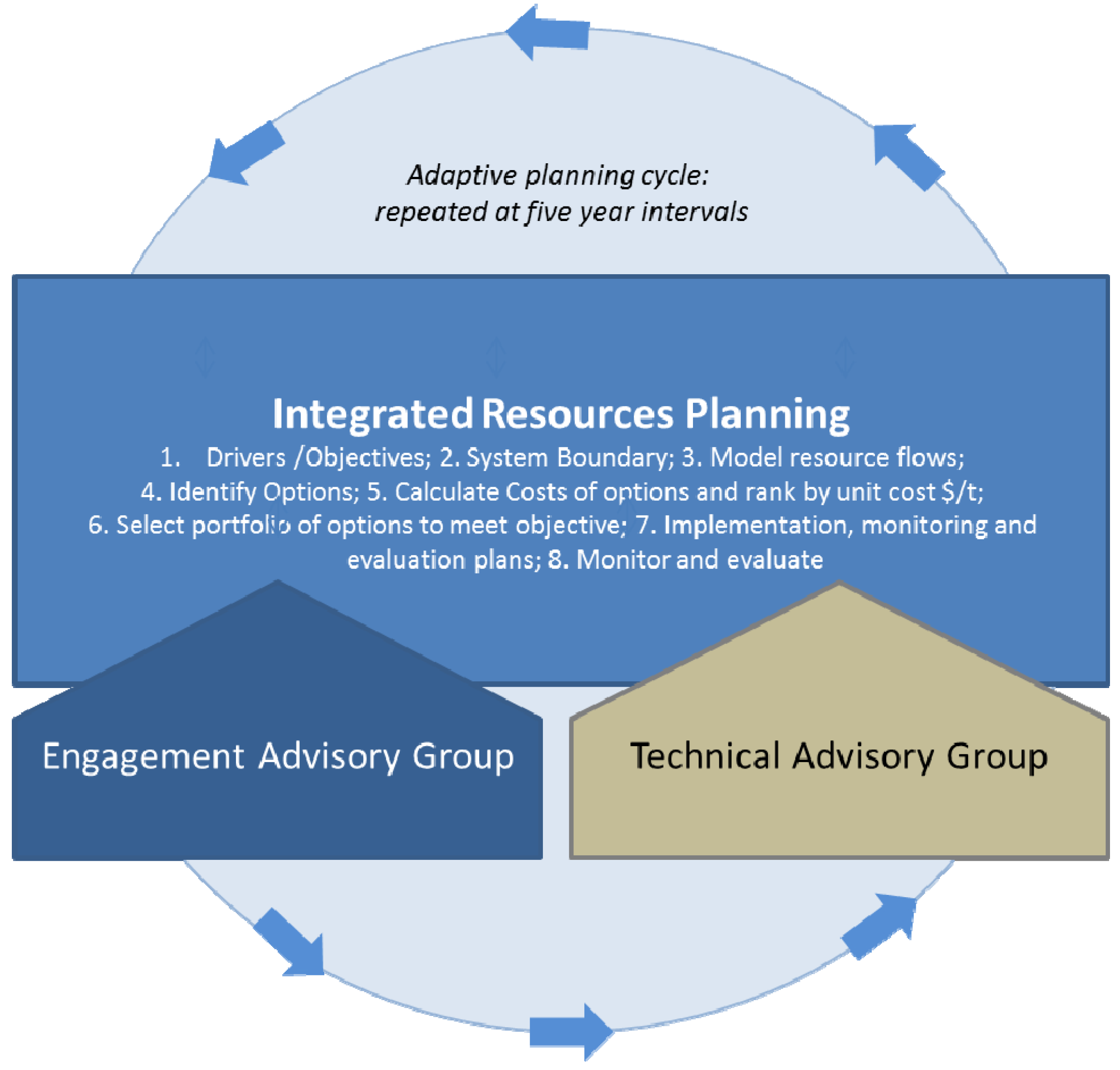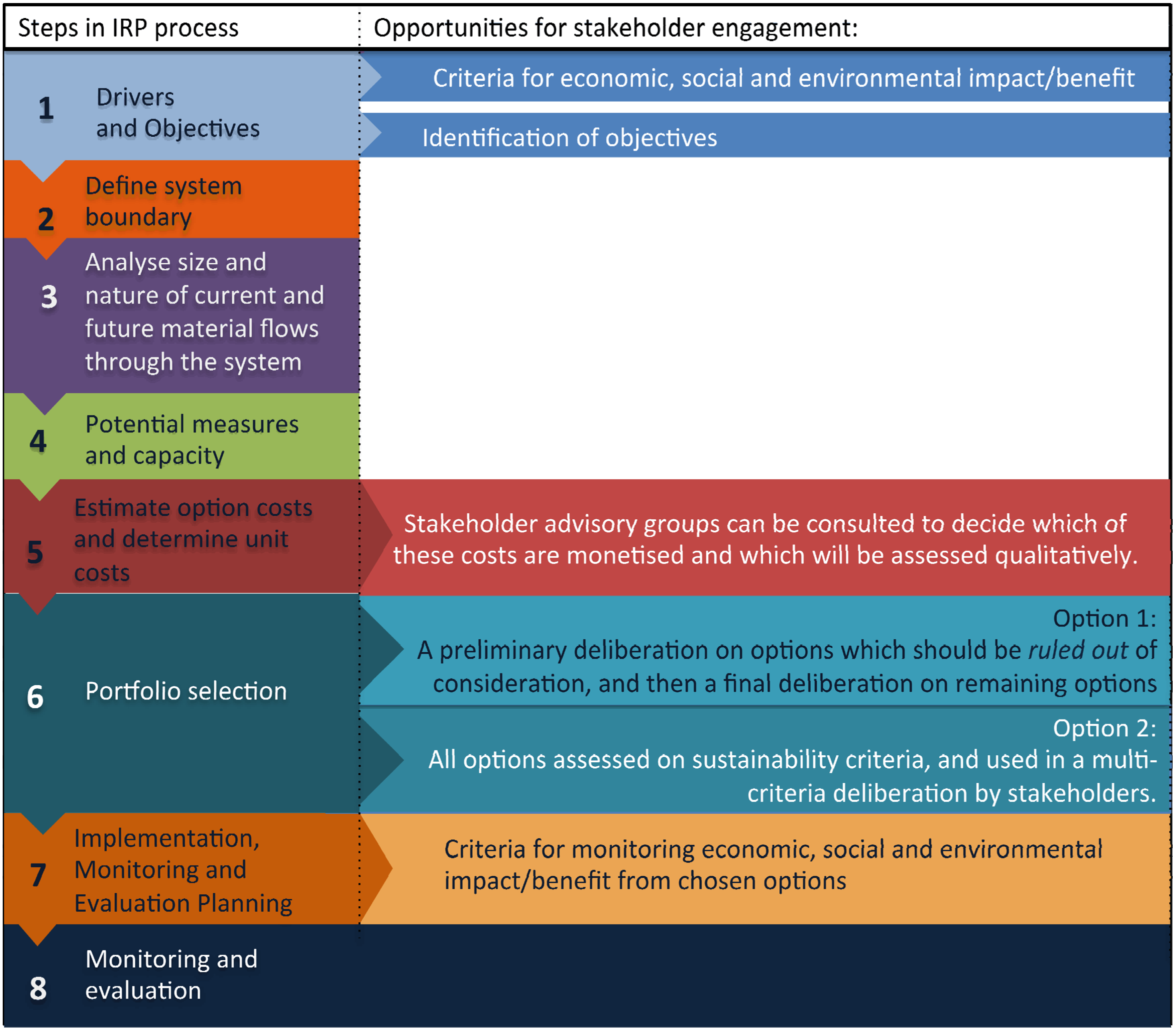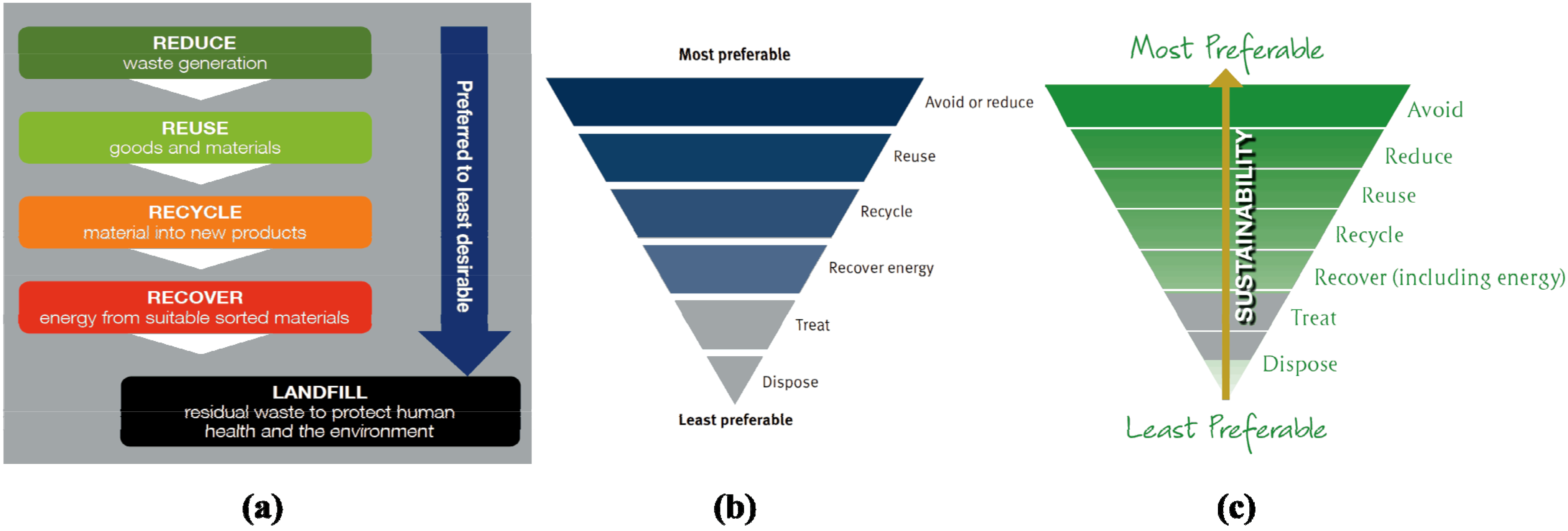Integrated Resource Planning for Urban Waste Management
Abstract
:1. Introduction
2. The Limitations of the Waste Hierarchy as a Guide to Waste Planning in the Australian Context
2.1. The Waste Hierarchy
2.2. Variations in Interpreting and Applying the Waste Hierarchy
2.3. Supplementary Criteria and Exceptions
| Perspetive | Focus |
|---|---|
| Policy developer | Broad cost and environmental effectiveness |
| Owner of facility | Cost and performance risks, approvals and siting, reliability of supply |
| Principal (metropolitan) | Political risk associated with cost and performance, community acceptance |
| Principal (regional) | Cost and performance risks, approvals and siting, reliance on landfill |
2.4. An International Perspective
- integrating spatial-temporal life cycle inventory analysis with multi-criteria optimization of environmental and economic solutions and a geographical information system for a case study in the UK [15];
- minimax regret optimization analysis used in a US case study that links estimated event-based waste stream simulation (based on different environmental, economic, legal and social conditions) with possible waste management alternatives, which following optimization analyses, emphasizes the trade-offs and associated regret evaluation with predetermined scenarios assessed using MCA [16]; and
- an interval-parameter stochastic robust optimization model for supporting municipal solid waste management under uncertainty, which improves upon the existing stochastic robust optimization and interval linear programming methods and uses a hypothetical municipal solid waste management system [17].
2.5. From Waste Hierarchy to Sustainable Waste Management
| SSD [ 5,20] | Process Oriented Questions | Existing Focus in Waste Management Planning in Australia |
|---|---|---|
| 1. Principles for the constitution of the system. | What is the nature of the system? | Largely ignored, role of material cycling in sustainable cities is poorly understood and main focus is on solid waste (not liquid). |
| 2. Principles for a favourable outcome of planning within the system; principles for sustainability as the desired outcome. | What is desirable/sustainable? | Implicit commitment to what is desirable as represented in waste hierarchy and National Waste Policy. Conflict between product-based growth economy and desire to reduce waste and what is desirable at local, regional and national scales. |
| 3. Principles for the process to reach the above outcome sustainably. | What processes can we use to reach desired outcome? | CBA dominates, reducing consistency within and between jurisdictions, indicating that the waste hierarchy is insufficient as a guide for decision-making. This is where IRP can be used. |
| 4. Actions and concrete measures. | What actions will we take? | Actions and concrete measures for waste management have been taken with limited or no consideration of steps 1–3. Actions are often therefore “end-of-pipe”. Increased production of waste has not been matched by an increased ability to manage it. |
| 5. Tools and metrics to monitor and audit. | How will we measure progress? | There has been insufficient commitment to measuring and monitoring; available data is inconsistent and inaccessible across jurisdictions, inhibiting good planning. |
3. Overview of Integrated Resource Planning
3.1. The Key Principles of IRP
- Service provision—This principle recognises that it is the service that is required (e.g., in water the clean clothes and aesthetically pleasing gardens) and not the water itself. This ultimately leads to the fundamental principle that a kilolitre of water saved per year is equivalent to a kilolitre supplied, allowing options which reduce water demand or build new infrastructure to provide water are assessed at once, thus overcoming a historical bias towards building new infrastructure to meet demand growth.
- Detailed demand forecasting—Disaggregation of demand into water end uses and sectors (e.g., household toilets and showers and commercial and industrial properties) enables detailed forecasting of demand but also provides an insight into conservation potential for options development from changed technologies and behaviours.
- Consideration of a broad spectrum of viable options that satisfy service needs—For water this means water efficiency, source substitution, reuse and supply options are all considered including a mix of both measures and instruments (economic, regulatory and educative).
- Comparison of options using a common metric, boundary and assumptions—In this way the economic analysis ensures that the service provider supplies services at the lowest cost to society as a whole. The common metric, the “levelised” or “unit” cost is measured for water in present value $/kilolitre for the multiple capital and operating costs and benefits that affect the multiple stakeholders involved in the implementation of each option. The common boundary means decision-makers consider benefits and externalities such as energy, greenhouse gases, social, environmental and risk issues for all options equally using the same basic assumptions such as discount rate and timeframe.
- A participatory process—This principle recognises that service provision interacts with many other facets of natural resource management, urban development and consumer preferences. Hence the involvement of a diverse group of stakeholders at particular parts of the planning process will be necessary to identify and respond to multiple needs and objectives.
- Adaptive management—The high emphasis on iteration means that the planning process is considered an on-going learning process in which initiatives are decided upon, implemented and evaluated in repeated cycles. In this way short-term needs are addressed, at the same time as ensuring movement towards desirable long-term outcomes. It also helps to minimize the risk of investment in large infrastructure that may not be fully utilized for many years.
3.2. Experience of IRP in Other Sectors
“IRP can identify a series of the most cost effective options, from the array of available generation technologies and transmission upgrades, as well as end use efficiency improvements and other demand side management (DSM) measures. This is because the costs of delivering and saving a kWh of electricity—from improved lighting retrofits or centralised thermal generation plants or decentralised biomass generation facilities—are compared on a “level playing field”. IRP is therefore technologically neutral, treating deferred or avoided end use demand as equivalent to “delivered supply of electricity.”
- recognition of both the need for economic rationalism for Treasury and translating value for community;
- sustainability to support community, be measurable and confidence inducing; and
- policy to recognise diversity and the need for IRP to deal with the diversity present in the waste sector that may be less prevalent in the water and energy sectors in which it has been applied to date.
| Energy | Electricity | Water | Transport | Waste | |
|---|---|---|---|---|---|
| Unit of focus | Energy (electricity, gas, renewable) PJ | Electricity only (kWh) | Potable water (ML) | No of trips, VKT | Tonnes waste generated |
| Challenges to using an IRP approach | System boundary (i.e., all energy needs for a city: heating, stationary energy or also transport) | Simplest | Recycled water demand, fit for purpose water | The number of trips to “supply service to a city” is unclear—how many trips should be allocated in a resource efficient city | Waste types; Waste per person in a resource efficient city is unclear |
| System boundaries | Multiple companies | Electricity utilities (one company) can often deal with supply and customer demand | Water utilities (one company) can often deal with supply and customer demand, thus cost savings from demand management can offset supply augmentation | Multiple transport modes | Diverse players along supply chain from product designers and builders to waste recyclers and landfill operators—incentives not aligned |
| Example | New Hampshire, USA requires electrical utilities to file a biannual “Least Cost Integrated Resource Plan” [30] | Various examples of energy and electricity IRP modelling in Australia and internationally [31] | Various short (drought) and long term water planning strategies in Australia [4,24,25] | Reframing urban transport decision making [32,33] | |
| Dominant stakeholders | Government, utilities | Utility | Utility, customers, water appliance manufacturers, Government | Transport Operator, users, government | Local government, federal and state, government, businesses, householders, individuals, waste service providers, waste transporters, product manufacturers |
3.3. Translating IRP to the Waste Sector
3.3.1. Identify Key Drivers and Objectives (Step 1)
3.3.2. Define System Boundary (Step 2)
3.3.3. Analyse Size and Nature of Current and Future Waste and Material Flows through the System (Step 3)
3.3.4. Options Identification and Characterisation (Step 4)
3.3.5. Estimate Option Costs and Determine Unit Costs (Step 5)
3.3.6. Select Portfolio of Options to Meet Objective (Step 6)
- (1)
- a preliminary deliberation on options which should be ruled out of consideration based on environmental and social criteria, and then a final deliberation on remaining options based on least economic cost [35]; and
- (2)
- all options are assessed on sustainability criteria defined earlier in the process, and this information becomes an input to a multi-criteria analysis involving relevant stakeholders.
3.3.7. Develop Implementation, Monitoring and Evaluation Plan (Step 7)
3.3.8. Monitoring and Evaluation (Step 8)
3.4. Stakeholder Engagement and Participation


3.5. The Case for Greater Participation in Waste Management Planning
- the requirement for more co-operation between councils;
- a distrust of new and unproven technologies;
- a fear of incineration; and
- reservations about making a long-term commitment to inappropriate or out-dated technology.
“Too often our members have found that policy decisions which can be easily implemented in metropolitan regions, where there are multiple service providers, cannot be implemented at reasonable cost in rural and regional locations. Fewer service delivery options means less competition, transportation distances almost always impact on the financial viability of service delivery and lack of a critical mass of market and/or product often means that sustainable delivery cannot be achieved.”[39]
“We encourage the Taskforce and the Department to continue to consult widely on the development of the Plan as it is only through a genuine consultative process that waste management issues can be successfully addressed.”[39]
4. A Worked Example to Illustrate IRP in an Australian Urban Waste Context
4.1. The Australian Capital Territory (ACT)
4.2. Future Projections in the Worked Example

4.3. Cost Effectiveness of Future Options

5. Conclusions
Acknowledgments
Author Contributions
Conflicts of Interest
References
- Environment Protection and Heritage Council (EPHC). National Waste Report 2010; Department of the Environment, Water, Heritage and the Arts: Canberra, Australia, 2010.
- Waste Management Association of Australia. Bioreactor Landfill Technology; Discussion Paper for Information and Comment; Waste Management Association of Australia, National Landfill Division: Sydney, Australia, 2008. [Google Scholar]
- Gertsakis, J.; Lewis, H. Sustainability and the Waste Management Hierarchy: A Discussion Paper for EcoRecycle Victoria; RMIT University: Melbourne, Australia, 2003. [Google Scholar]
- Turner, A.; Willetts, J.; Fane, S.; Giurco, D.; Chong, J.; Kazaglis, A.; White, S. Guide to Demand Management and Integrated Resource Planning (Update on Original 2008 Guide); Institute for Sustainable Futures, University of Technology Sydney: Sydney, Australia, 2010; pp. 1–174. Available online: https://letscrate.com/o9B (accessed on 8 December 2014).
- Robert, K.H.; Schmidt-Bleek, B.; Aloisi de Larderel, J.; Basile, G.; Jansen, J.L.; Kuehr, R.; Price Thomas, P.; Suzuki, M.; Hawken, P.; Wackernagel, M.; et al. Strategic sustainable development—Selection, design and synergies of applied tools. J. Clean. Prod. 2002, 10, 197–214. [Google Scholar] [CrossRef]
- ACT Government. ACT Waste Management Strategy—Towards a sustainable Canberra 2011–2025; Environment and Sustainable Development Directorate: Canberra, Australia, 2011.
- Department of Environment and Heritage Protection (EHP). Waste-Everyone’s responsibility: Queensland Waste Avoidance and Resource Productivity Strategy (2014–2024); Department of Environment and Heritage Protection, Queensland Government: Brisbane, Australia, 2014.
- Government of South Australia. South Australia’s Waste Strategy 2011-2015; Zero Waste SA, Government of South Australia: Adelaide, Australia, 2011.
- Wright Corporate Strategy. ACT No Waste Strategy & Targets: Review & Assessment of Options (Revised Final Report); ACT NoWaste: Sydney, Australia, July 2008. [Google Scholar]
- Costello, L.N.; Dunn, K. Resident action groups in Sydney: People power or rat bags? Aust. Geogr. 1994, 24, 67–76. [Google Scholar]
- Cordell, D.; Moore, D.D.; Gero, A.; Herriman, J.; Mason, L.; White, S. Sustainability Costs and Challenges of Waste Management and Mitigation in Australia; Institute for Sustainable Futures, University of Technology Sydney: Sydney, Australia, 2012. [Google Scholar]
- European Commission. Being Wise with Waste: The EU’s Approach to Waste Management. Available online: http://ec.europa.eu/environment/waste/index.htm (accessed on 4 January 2015).
- Finnveden, G.; Ekvall, T.; Arushanyan, Y.; Bisaillon, M.; Henriksson, G.; Gunnarsson Östling, U.; Ljunggren Söderman, M.; Sahlin, J.; Stenmarck, Å.; Sundberg, J.; et al. Policy Instruments towards a Sustainable Waste Management. Sustainability 2013, 5, 841–881. [Google Scholar] [CrossRef]
- Morrissey, A.J.; Browne, J. Waste management models and their application to sustainable waste management. Waste Manag. 2004, 24, 297–308. [Google Scholar] [CrossRef] [PubMed]
- Shmelev, S.E.; Powell, J.R. Ecological-economic modeling for strategic regional waste management systems. Ecol. Econ. 2006, 59, 115–130. [Google Scholar] [CrossRef]
- Chang, N.B.; Davila, E. Minimax regret optimization analysis for a regional solid waste management system. Waste Manag. 2007, 27, 820–832. [Google Scholar] [CrossRef] [PubMed]
- Xu, Y.; Huang, G.H.; Qin, X.S.; Cao, M.F.; Sun, Y. An interval-parameter stochastic robust optimization model for supporting municipal solid waste management under uncertainty. Waste Manag. 2010, 30, 316–327. [Google Scholar] [CrossRef] [PubMed]
- Weng, Y.C.; Fujiwara, T. Examining the effectiveness of municipal solid waste management systems: An integrated cost-benefit analysis perspective with financial cost modeling in Taiwan. Waste Manag. 2011, 31, 1393–1406. [Google Scholar] [CrossRef] [PubMed]
- Broitman, D.; Ayalon, O.; Iddo, K. One size fits all? An assessment tool for solid waste management at local and national levels. Waste Manag. 2012, 32, 1979–1988. [Google Scholar] [CrossRef] [PubMed]
- Seadon, J.K. Integrated Resource Management. Ph.D. Thesis, University of Auckland, Auckland, New Zealand, 1 July 2010. [Google Scholar]
- American Water Works Association. Integrated Resource Planning: A Balanced Approach to Water Resources Decision-Making; American Water Works Association (AWWA) Research Foundation by Barakat and Chamberlin, American Water Works Association: Denver, CO, USA, 1994. [Google Scholar]
- Swisher, J.N.; de Martino Jannuzzi, G.S.; Redlinger, R.Y. Tools and Methods for Integrated Resources Planning: Improving Energy Efficiency and Protecting the Environment; UNEP Collaborating Centre on Energy and Environment, Riso National Laboratory: Roskilde, Denmark, 1997. [Google Scholar]
- Tellus Institute. Best Practices Guide: Integrated Resource Planning for Electricity; The Energy Group, Institute of International Education: Washington, DC, USA, 2000. [Google Scholar]
- White, S. Demand Management and Integrated Resource Planning in Australia. Proceedings of the Efficient Use and Management of Water for Urban Supply Conference, Madrid, Spain, 21–23 May 2001; Available online: http://cfsites1.uts.edu.au/find/isf/publications/white2001demandmanagementAustralia.pdf (accessed on 15 January 2015).
- Institute for Sustainable Futures, UTS. Integrated Resource Planning for Urban Water—Resource Papers; Waterlines Report Series No. 41; National Water Commission, Government of Australia: Canberra, Australia, 2011. Available online: https://letscrate.com/o9D (accessed on 8 December 2014).
- National Water Commission. Australian Integrated Resource Planning Framework and Manual—Progress; National Water Commission, Government of Australia: Canberra, Australia, 2009. Available online: http://archive.nwc.gov.au/rnws/urban/integrated-resource-planning/australian-integrated-resource-planning-framework-and-manual-progress (accessed on 15 January 2015).
- D’Sa, A. Integrated Resource Planning (IRP), Part 1: Recent Practice for the Power Sector; International Energy Initiative (IEI): Bangalore, India, 2011. [Google Scholar]
- Lovins, A.B. Energy strategy: The road not taken. Foreign Aff. 1976, 55, 65. [Google Scholar] [CrossRef]
- Herriman, J.; Asker, S.; Gero, A.; Mason, L.; Cordell, D.; Moore, D.D.; White, S. Waste Futures: Workshop Report; Institute for Sustainable Futures, University of Technology, Sydney: Sydney, Australia, 2012. [Google Scholar]
- Scholer, K. State Analysis and Survey on Restructuring and Regulation: Final Report; Maryland Public Service Commission: Baltimore, US, 2008. [Google Scholar]
- Dunstan, C.; Cooper, C.; Glassmire, J.; Ison, N.; Langham, E. Evaluating Costs of Decentralised Energy, Working Paper 4.3; CSIRO Intelligent Grid Research Program by the Institute for Sustainable Futures, University of Technology, Sydney: Sydney, Australia, 2011. Available online: http://igrid.net.au/resources/index.html (accessed 15 January 2015).
- Chong, J.; Brennan, T.; McKibbin, J.; White, S. Easy Travel Strategies—Integrated Resource Planning Final Report; TransLink Transit Authority by the Institute for Sustainable Futures, University of Technology, Sydney: Sydney, Australia, 2011. [Google Scholar]
- White, S.; Brennan, T. Reframing urban transport decision making. Rail Express 2010, 3, 87–91. [Google Scholar]
- Giurco, D.; Moore, D.; Mason, L.; Herriman, T.; Boyle, T.; White, S. Integrated Resource Planning for Waste—Technical Report; Institute for Sustainable Futures, University of Technology, Sydney: Sydney, Australia, 2012. [Google Scholar]
- White, S.; Fane, S.A.; Giurco, D.; Turner, A.J. Putting the Economics in Its Place: Decision-Making in an Uncertain Environment; Zografos, C., Howarth, R., Eds.; Deliberative Ecological Economics, Oxford University Press: New Delhi, India, 2008; pp. 80–106. [Google Scholar]
- National Coalition for Dialogue & Deliberation. Core Principles for Public Engagement. Available online: http://www.ncdd.org/pep/ (accessed on 8 December 2014).
- GHD. Waste Technology and Innovation Study Final Report; Department of the Environment, Water, Heritage and the Arts: Canberra, Australia, 2009.
- Gero, A.; Herriman, J.; Cordell, D.; Mason, L.; Moore, D.D.; White, S. Landfill Futures: Stakeholder Interview Summary Report; Institute for Sustainable Futures, University of Technology, Sydney: Sydney, Australia, 2012. [Google Scholar]
- Riverina Eastern Regional Organisation of Councils (REROC). A National Waste Policy: Managing Waste to 2020; REROC: Wagga Wagga, Australia, May 2009. [Google Scholar]
- ACT Government. Draft ACT Sustainable Waste Strategy 2010–2025; ACT Government: Canberra, Australia, 2010.
- APrince Consulting Pty Ltd. ACT Landfill Audits: Combined Final Audit Report; ACT NO Waste: Sydney, Australia, July 2010. [Google Scholar]
- URS. Economic Modelling of Options for Waste Infrastructure in the ACT; Supplementary Report; 27 August 2010. [Google Scholar]
- Hyder Consulting Pty Ltd. Australian Landfill Capacities into the Future; Department of the Environment, Water, Heritage and the Arts: Canberra, Australia, 2009.
© 2015 by the authors; licensee MDPI, Basel, Switzerland. This article is an open access article distributed under the terms and conditions of the Creative Commons Attribution license (http://creativecommons.org/licenses/by/4.0/).
Share and Cite
Giurco, D.; Herriman, J.; Turner, A.; Mason, L.; White, S.; Moore, D.; Klostermann, F. Integrated Resource Planning for Urban Waste Management. Resources 2015, 4, 3-24. https://doi.org/10.3390/resources4010003
Giurco D, Herriman J, Turner A, Mason L, White S, Moore D, Klostermann F. Integrated Resource Planning for Urban Waste Management. Resources. 2015; 4(1):3-24. https://doi.org/10.3390/resources4010003
Chicago/Turabian StyleGiurco, Damien, Jade Herriman, Andrea Turner, Leah Mason, Stuart White, Dustin Moore, and Frank Klostermann. 2015. "Integrated Resource Planning for Urban Waste Management" Resources 4, no. 1: 3-24. https://doi.org/10.3390/resources4010003







